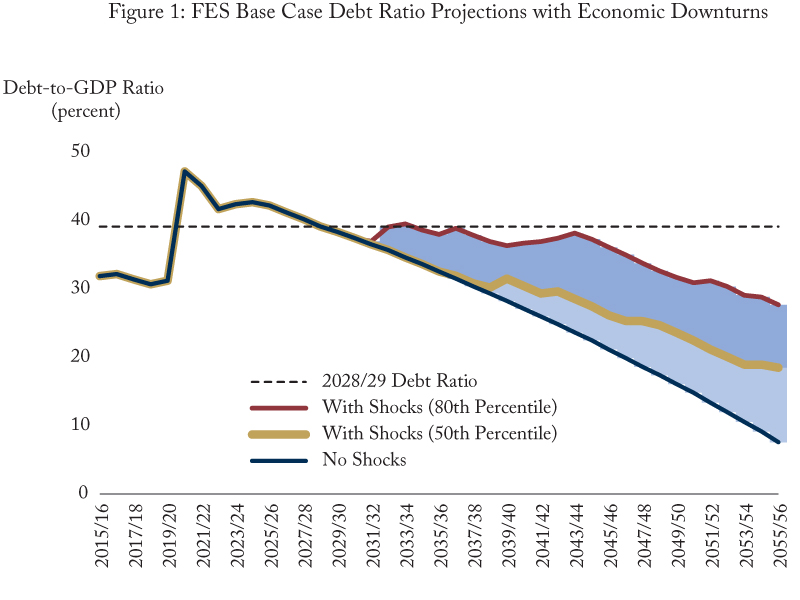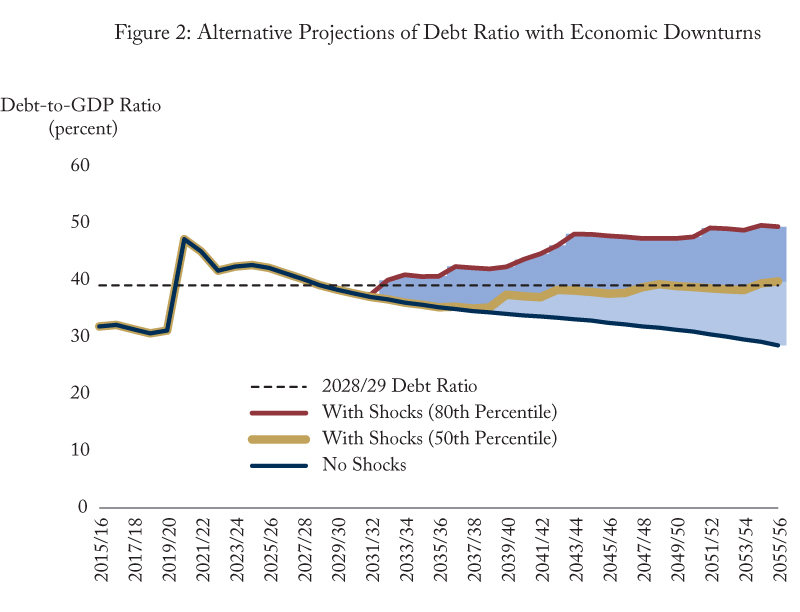To: Canada’s budget observers
From: John Lester and Alexandre Laurin
Date: January 5, 2024
Re: The Federal Debt is Not Sustainable
The recent Fall Economic Statement (FES) contains a familiar rosy assessment of federal debt sustainability. It shows the ratio of debt to GDP declining continuously over 30 years starting in the second year of the medium-term forecast, landing gently on 7.6 percent by 2055-56. This outcome is implausible for three reasons.
First, the effective interest rate on federal debt remains below the growth rate of the economy for 33 years, ending in 2055/56, placing continuous downward pressure on the debt ratio. This is optimistic. Over the 33 years ending in 2022-23, the average value of the effective rate exceeded the average GDP growth rate by 0.5 percentage point.
Second, revenues are assumed to rise faster than program spending in the economic statement’s projection. Revenues are assumed to grow broadly in line with GDP. While direct program spending is assumed to grow at the same rate as GDP, growth in major transfer payment programs is determined by legislated escalators or movements in program drivers. This version of a “no policy change” assumption results in overall program spending falling as a share of GDP, which puts sustained downward pressure on the debt ratio through a rising operating surplus (revenues less program spending).
In other words, the FES projection is based on the assumption that there will be 33 years of fiscal austerity. We think a more credible approach is to build in the no policy change assumption by maintaining program spending at a constant share of GDP over the projection period. With this approach, we assess debt sustainability when the operating balance is on average over the projection period the same share of GDP as in 2028-29.
Third, and most important, is the failure to include economic downturns in the projection. Economic shocks are certain to interrupt growth over the projection period. Over the past 60 years there have been five recessions, all of which have prompted governments to respond with temporary stimulus measures to support incomes. In contrast to automatic stabilizers like Employment Insurance, which increase debt during downturns and reduce it during upswings, these discretionary measures cause a permanent increase in debt.
As discussed in our E-Brief last March, we capture the effects of economic downturns on the debt ratio by simulating 1,000 randomly generated scenarios in which future recessions and government responses to them are similar to those over the prior 60 years. We do not know when, how often, or how hard recessions will hit federal finances, but our simulations allow us to assess the probability of various fiscal outcomes.
The impact of including economic downturns in the FES projection is illustrated in Figure One. The straight dark blue line shows the base case projection. The gold line shows the typical simulated debt ratio when economic downturns are included. The red line shows the debt ratio for the projection on the 80th percentile of our scenarios. In this scenario, the debt ratio is close to or above its 2028/29 value (dotted line) from 2032/33 to 2036/37, but is on a steep downtrend thereafter. According to the IMF classification scheme, this outcome means that the 2028-29 debt ratio is sustainable with high probability, even when the impacts of economic downturns are included.

However, more realistic assumptions about program spending and the gap between interest rates and GDP growth change this assessment. In our alternative debt projection, we assume that program spending grows at the same rate as GDP and that on average over the projection period, interest rates closely track GDP growth. Given the historical record, our interest rate assumption is prudent.
Our analysis is summarized in Figure Two. In our base case (dark blue line) the debt ratio declines much less than in Ottawa’s base case. Our interest rate assumption adds 3 percentage points to the 2055/56 debt ratio, while our assumption about program spending adds 18 percentage points. Including the impact of recessions eliminates the downward trend in the debt ratio for the typical (50th percentile) scenario (gold line). The typical debt ratio starts increasing in 2038/39 and is close to or above the 2028/29 debt ratio (dotted line) for the last nine years of the projection period. In other words, there is an even chance that the debt ratio will exceed its 2028/29 value late in the projection period. Under the International Monetary Fund’s classification scheme, Canada’s debt would be considered unsustainable.
More ominously, there is a non-negligible risk that the debt ratio will start its upward trend earlier and will rise well above its 2028/29 value. There is a 20 percent probability that the debt ratio will be above its 2028/29 value by 2032/33 and that the debt ratio will rise about 10 percentage points above its starting level by the end of the projection period. (The red line in Figure 2, which represents the scenario on the 80th percentile of the simulations.)

For Canada’s debt to be considered sustainable with high probability in the IMF classification scheme, the red line in the above figure must remain below the debt ratio in 2028/29. That is, the probability that the debt ratio will rise above its 2028/29 value has to be less than 20 percent. To meet this sustainability condition, the federal government would have to take measures to permanently increase the operating balance by $13 billion in 2028/29. This could be achieved by raising the GST by almost 1 percentage point or reducing program spending by more than 2 percent.
John Lester is a Fellow-in-Residence and Alex Laurin is Director of Research at the C.D. Howe Institute.
To send a comment or leave feedback, email us at blog@cdhowe.org.
The views expressed here are those of the authors. The C.D. Howe Institute does not take corporate positions on policy matters.





